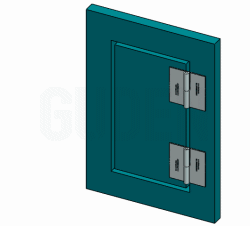Things to Consider When Choosing a Slip Joint Hinge

Sampling and Testing
Want free slip joint engineering samples? Sure! We know the value of prototyping and testing, and we strive to fill reasonable design sample requests quickly. Building a prototype shouldn't have to be a major expense and an engineering analysis of a prototype is usually the best way to confirm that you have selected a safe and effective product for your application. Working with the right supplier is the key to the success of your design process and you've already made a great choice with Guden, the hardware experts. With almost 100 years of experience, the samples, information and advice you can get from us can be priceless in getting your prototype off the ground and onto the production floor.

Alignment
Slip hinges allow for easy removal of a door or cover but require careful pin alignment for smooth operation. Be sure to account for alignment in your mounting. For larger doors, you may also want to consider a continuous slip hinge.
Space For Removal
Slip joints operate by sliding the female hinge off the pin on the male hinge. You need to take note of the length of the pin, and make sure you have at least that distance of space in the up direction (on vertical doors) or to the side (on horizontal doors) to remove the door.
Right or Left Hand Version
Slip joint hinges are supplied in a right hand version and a mirror image left hand version. Depending on the side that you're mounting the slip hinge on, and where you're mounting it will determine which version you want. Typically, if the hinge is mounted on the outside of the chassis and door, then right hand versions are used for the right hand side of your door, and vice versa. Check our helpful video on how to tell a right hand slip hinge from a left hand .
Leaf Material and Thickness
| • Cold Rolled Steel - Affordable |
| • Stainless Steel - Corrosion Resistant |
| • Aluminum - Lightweight |
Plain steel and type 302/304 stainless steel are the most popular material choices for a slip joint hinge.
With type 316 stainless steel and aluminum also available as well. It is also common to have the hinge material match the material of
the cabinet or box.
For material thickness, a good starting point is to select the same thickness as the enclosure.
If the enclosure has some unusual weight distribution, or a high or low door loads you may want to increase or possibly decrease
the thickness.
Pin Size and Retention
| • Staked Pin - the knuckle is lightly punched to grip the pin |
| • Knuckle Curled Tight for Retention - the specially tight knuckle holds the pin |
| • Knurled or Splined Pin - grooves in the pin grip to walls of knuckle |
| • Pin Welded in Place - the pin is welded in place to the end knuckle |
As a basic rule, there are usually 1 or 2 options for a pin diameter with a given thickness of a slip joint hinge. Most often, the strongest slip joint hinge is one where the pin diameter is about twice the material thickness. For a slip hinge, the pin being stationary is most important so it's retention is key. You may have a choice for how the pin is retained, but in all situations, for the hinge to work, it must be fixed in place on the male hinge half.
With or Without Mounting Holes
| • No Holes for Welding |
| • Standard Holes or Slots |
| • Standard Countersunk Holes |
| • Custom Holes or Slot Sizes or Patterns |
| • Custom Threaded Inserts |
Many hinges without holes are mounted by welding, but for easier mounting, many hinges can also be supplied with holes, slots or custom threaded inserts or studs. Various standard hole patterns are readily available and just about any hole pattern you need can also be supplied. Keep in mind that some non-standard patterns may require a tooling charge.
Custom Bends / Cuts / Swages
If you are modifying the hinge, it may also be good to compare how cost effective it is to have the supplier do the operations for you. In addition to holes, slots and plating, slip joint hinges can also be cut to width, bent, swaged, and offset - nearly anything is possible. Larger sizes, thicknesses and lengths can also be supplied. Simply provide us with a dimensional drawing to get a price quote.
Finish
| • Chemical Conversion | • Degrease | • Powder-coat |
| • Anodize | • Electro-Galvanize | • Polish |
| • Black Oxide | • Electropolish | • Passivate |
| • Burnished | • Nickel | • Zinc |
| • Chrome | • Paint | • NADCAP |
Many stock slip hinges are plain finish metal, but there are also plated versions available as well. Often your slip joint hinge will be finished along with the rest of your assembly, but if needed, Guden can supply the hinge with your specified finish. We also have a line of electro-polished stainless slip joint hinge that has holes and rounded corners. It's suitable for the marine industry or any application that needs a corrosion resistant hinge with a bright shiny finish.
Considering a Slip Joint hinge for your application?
Click here to see our standard Slip Joint hinges


